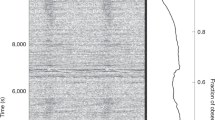Abstract
Backer et al.1 have reported the discovery of a pulsar with the period of 1.558 ms, identified with the source 1937 + 214 (=4021.53). The extreme rotational velocity and high energy loss rate of this object make it a very interesting astrophysical phenomenum not only as an important clue for the physics of neutron stars and supernova remnants, but also as a potential strong emitter of gravitational radiation (S. White and J. Arons, personal communication). I present here an optical identification candidate for the millisecond pulsar: it is a 20th mag red object, undetectable on the Palomar Sky Survey prints. Finding charts and offsets from nearby stars are given.
This is a preview of subscription content, access via your institution
Access options
Subscribe to this journal
Receive 51 print issues and online access
$199.00 per year
only $3.90 per issue
Buy this article
- Purchase on Springer Link
- Instant access to full article PDF
Prices may be subject to local taxes which are calculated during checkout
Similar content being viewed by others
References
Backer, D., Kulkarni, S., Heiles, C., Davis, M. & Goss, W. Nature 300, 615–618 (1982).
Author information
Authors and Affiliations
Rights and permissions
About this article
Cite this article
Djorgovski, S. Optical identification of the millisecond pulsar 1937+214. Nature 300, 618–619 (1982). https://doi.org/10.1038/300618a0
Received:
Accepted:
Issue Date:
DOI: https://doi.org/10.1038/300618a0
This article is cited by
-
Search for pulsed optical emission from the millisecond pulsar PSR1937 + 214
Nature (1984)
-
Millisecond pulsars
Journal of Astrophysics and Astronomy (1984)
-
On the magnetization and origin of the millisecond pulsar 1937 + 214
Nature (1983)
-
High-resolution X-ray and radio maps of the millisecond pulsar
Nature (1983)
-
Searches for optical counterparts of the two millisecond pulsars
Nature (1983)
Comments
By submitting a comment you agree to abide by our Terms and Community Guidelines. If you find something abusive or that does not comply with our terms or guidelines please flag it as inappropriate.



